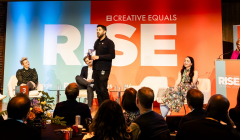
Are we leaving men and boys behind?
At Creative Equal’s RISE event, industry leaders consider how to reframe boys and men in marketing

Adam Murphy, Experience Director, Philips Design on how design can make a difference.

“As creative people we have great power, but we must ask ourselves are we reimagining a more inclusive space or are we reinforcing a homogeneous one?”
Adam Murphy, Experience Director at Philips Design is challenging the creative industries to create positive change when it comes to opening up the design industry for more diverse perspectives.
Speaking at Creative Equals RISE conference, Murphy urged the industry to reimagine the systems it works within to create a more diverse space.
He explained: “As creatives, our most important quality is the passing of information...to create positive stories of advancement”
Murphy, who opened his talk with a traditional Māori introduction, ‘Pepeha’, which is a description that links who you are to the land, mountain, river, sea, and tribe, urged the audience to consider the lens through which they are viewing the world and creating work.
He explained: "Reflect on your own Pepeha. Where did you come from? How did you get here?"
Exploring how design can elevate the message and create impact and understanding of the world around us, Murphy said that design is ultimately a reflection of our society.
Yet a reflection that must be carefully considered. Pointing to the work of graphic designer Shamma Buhazza, who transformed Pinterest into a resource to decolonise design, he urged the industry to think carefully about the messaging and systems they are reinforcing.
“Even within the creative industry itself, the dominant design aesthetic has been binary and male,” he explained.
How can we change thinking modes and structures established in a different time and context?
Adam Murphy, Experience Director, Philips Design
Murphy spoke eloquently on the way in which the creative process can reinforce the dynamics of homogeneity. He urged the industry to question its process and ask: “How can we change thinking modes and structures established in a different time and context?”
He continued: “If systems are all about relationships [then we need to ask] what does a good relationship look like?”
It is an approach which demands critical thinking from the industry; particularly in the midst of an intense focus on convenience as the direct to consumer market continues to grow exponentially. As Murphy explains: “Design is a reflection of culture and we live in a design led culture. We praise the value of convenience but through these forces we get to a place of homogeneity.”
Looks like you need to create a Creativebrief account to perform this action.
Create account Sign inLooks like you need to create a Creativebrief account to perform this action.
Create account Sign in